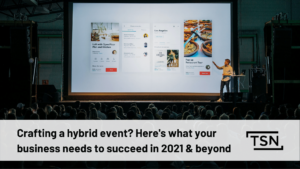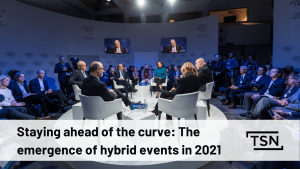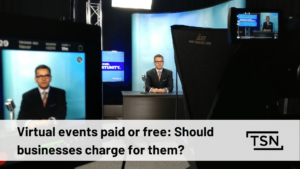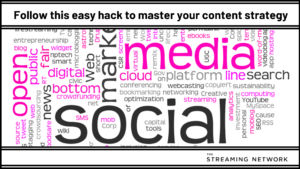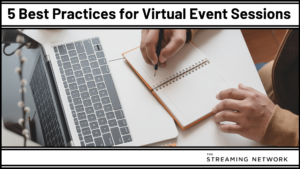Did you know that 34 per cent of event organizers will invest more in hybrid events this year and in years to come?
The future of events is decidedly hybrid.
It’s a new age. Chalk it up to the lasting impact of the Covid-19 pandemic. The events industry underwent a seismic change in 2020, shifting to the digital realm en masse. And even with the strong push for vaccinations and the re-opening of retail businesses this year, there remains a lot of uncertainty about returning to full-blown in-person events. With so many of us continuing to work remotely and new variants of the virus lingering, hybrid events are smoothing out the transition.
So, are you looking to build the perfect hybrid event for your business? While the prospect may seem daunting initially, given the right tools and considerations, it is a lot easier than you might think.
We’ll guide you through the essentials and what you can expect from this event format along with several avenues that your business can take to put on a hybrid event.
What do you need for a successful hybrid event?
So, you want to incorporate hybrid events into your offering – but where do you begin? A successful hybrid event requires, at minimum, the following aspects:
- A solid hybrid event platform. The best platforms are fully featured but don’t overwhelm users with their complexity or devour their wallets. We recommend our very own Engage Webinars platform with its unlimited customization, in-depth analytics, scalability and a deep set of engagement options for all your virtual and hybrid events.
- Strong engagement. This is an absolutely essential part of a successful hybrid event. Unlike a purely in-person event, you don’t control the environments of those participating virtually. As such, you need to provide a short but memorable experience, where they can interact with your ideas and personalized content, whether it’s through Q&A’s, polls, giveaways or surprises (a guest speaker) if appropriate.
- An appropriate venue. Around 35 per cent of event organizers cite this as one of their biggest challenges. Try finding something that fits your goals and allows you to cater to all your audiences, live and online, at the same level.
- A contingency plan. Even the best ideas can experience hiccups. The success of virtual and hybrid events depends on keeping all potential issues like venue(s) capacity, registrations, check-ins and different time zones in mind. Be prepared ahead of time to avoid unnecessary interruptions for your attendees.
Applying the lessons learned producing virtual to hybrid events
For those of us with years in the virtual events business, the pandemic re-enforced what we already knew (for the most part). Remember the first time you watched a Covid-19 relief concert or awards show from home on YouTube? We were all in it together and although it did not capture the energy of being at a live concert, it did put everyone on a level playing field.
That virtual event content was produced with one audience in mind, those at home watching on their TV or computer screen – and you could tell. The lead singer was not projecting his or her voice on a stage at throngs of in-person fans.
Instead, the singer looked straight into the camera and spoke directly to us. To make it even more impactful, the event took place from a living room, implying that these uber-rich and famous musicians were at that moment in the same predicament as we were.
The allure of the at-home concert faded almost as quickly as the allure of the at-home, post-event “cocktail hour” within our corporate virtual events, but it did create an important dynamic that is at the heart of your hybrid plans.
If you are going to include a virtual component to your in-person event, then you cannot make your remote attendees an afterthought. This means that your event production will need to make the “at-home” audience members feel more like they are part of the experience than you did pre-pandemic. Providing compelling virtual experiences will be absolutely essential.
Remember, not everyone is going back to business as usual. There will be virtual-only events going into 2022, many possibly produced by your competitors. Like you, they have learned quite a lot from these early virtual events and will be tailoring their content accordingly. This means that those who are planning hybrid events need to consider how they will compete for that audience.
With that in mind, what follows are the best options for creating an engaging hybrid event that makes sense for most types of businesses.
OPTION 1: Traditional hybrid “The big company play”
Based upon what we are hearing from our customers and what we are reading online, there’s every indication that larger companies will take their major events towards hybrid. This will mean a full fledged in-person event that scales up or down based on ticket sales, with a full virtual component to capture groups unable or unwilling to physically attend.
These companies have the budget and the reach to invest equally in both formats and will allow the attendees to decide how they want to participate in the hybrid event.
The only difference for most of them – based on the virtual event lessons learned during the pandemic – will be ensuring that the right amount of attention is put on the virtual attendees. As stated earlier, they won’t want the participants at home to feel as through they are simply watching something happen that was created for an in-person audience and broadcast online.
This means that the digital aspect of hybrid events will include items that were regularly ignored during pre-pandemic:
- Exclusive content for the virtual attendees, including virtual-only Q&A sessions with speakers and virtual-only networking events.
- Ability for the virtual audience to interact with speakers, sponsors and other participants.
- Time shifting and localizing of content for international audiences.
- On-demand access for all audience members. Virtual and in-person alike will have the opportunity to review content they enjoyed at the conference or those sessions they missed during the live broadcast.
- Connecting physical and virtual audiences will be top of mind. Through the advancements in technology made during the pandemic, it is realistic to expect as a virtual attendee that you can connect and interact with in-person attendees, not just your digital counterparts.
OPTION 2: Reverse hybrid “Looks like a traditional hybrid event but it’s not”
The reverse hybrid event is a safer bet than the traditional hybrid event and is likely how many businesses plan to ease back into physical events. In this model, a location is selected for the event – commonly the headquarters of the company or a location where most attendees are located – while the physical event consists primarily of the speakers and other key attendees.
Essentially, it has all the trappings of a physical event, with a stage, live audience and social events, but everything is scaled back from what was pre-pandemic. On the flip side the virtual event and the virtual attendees are the primary audience, with the agenda/content mainly targeted at them. What you’ll see with these types of hybrid events includes the following:
- More virtual sessions/content – In-person attendees might enjoy one day or one track of content, while digital audiences receive the full conference agenda live.
- Sponsors are virtual – Since the virtual audience is larger than the physical audience, sponsors will be staffing both physical and virtual booths or potentially just the latter. On the other hand, employees from the sponsoring companies will attend the physical event, if possible, with attendee passes.
- The virtual audience has a voice – Remote audience members can submit questions and interact with event speakers, while networking with other virtual attendees. In this model, the physical audience understands that like the Academy Awards or the GRAMMYs, they may be in the front row, but the event is really being produced for audiences watching in a virtual setting. So, they will understand when certain things are done to bring that audience to the forefront that would not normally be done for a traditional face-to-face, live setting.
OPTION 3: The multi-venue approach
A common pre-pandemic practice among pharmaceutical companies for brand launches, the multi-venue approach provides the best of both worlds. This model sees multiple venues participating in the event, with a digital component to cover off regions not represented with a venue or attendees in a post-pandemic world unprepared to congregate with others for an onsite experience.
There is commonly a primary broadcast location where most, if not all, event speakers are located as well as satellite locations that stream the program and allow an audience to experience the content with others.
In one brand launch we were a part of several years ago, we saw audience members from the five satellite locations comparing the wine on the table and the menu over the internal event chat. However, the technology to connect attendees was not available for a company wanting to keep the dialogue private and off traditional social media channels. That has all changed, so this option is now much more viable.
Another challenging aspect of that event was having experts from each satellite location participate as speakers and lead discussions of key topics of interest. But yet again, with recent advancements in technology, this process has become infinitely easier to address.
The key aspects to making this approach work is like single location events, but requires a three-pronged approach to audience engagement:
- Satellite attendees should be able to interact with speakers in the broadcast location as well as attendees in other locations.
- Bringing in speakers from satellite locations is easier than it has ever been and will also ensure that the experts/speakers in each location are given the same weight as those in the primary broadcast location.
- Networking may work best if it is segregated in this approach. Since you’ve gone to such lengths to set up these satellite locations, it will only make sense to dedicate a portion of your event agenda for regional networking as well as digital-only networking events.
OPTION 4: The non-hybrid/hybrid event
There was a long-standing practice of recording event content and posting it on-demand for those unable to attend in-person. Personally, we don’t believe this will cut it with today’s audience but that doesn’t mean that recording an event or a conference is a waste of your time and money.
In the pre-pandemic world, we had success with event organizers who were afraid of producing a hybrid event, lest it impact their in-person audience numbers and the ‘perceived’ success of their session. They had the foresight to record the event, but were under pressure to produce results, so we recommended a command performance of the event virtually.
The command performance is different from simply posting the videos on-demand. it takes the content from the conference and re-broadcasts it live at a new date and time for a digital audience. It’s marketed to everyone who chose not to attend in-person and makes use of now common virtual production practices:
- Simulated live sessions with live Q&A is offered to give virtual attendees the opportunity to ask questions of the speaker and interact with subject matter experts.
- Content is re-packaged for virtual. Some content may play better in bite-sized portions or combined with other speakers and so, the break between the live day and “command performance” allows for the re-packaging of content.
- New content is often added. There is this assumption that the original programming was not engaging enough to motivate a portion of the target audience members to attend. As a result, additional content assets such as recorded videos and webinars or exclusive “Ask Me Anything” sessions with certain speakers are added to the agenda in hopes of drawing in a wider audience.
What’s best for you?
As an event planner, you are keenly aware that you need to listen to your audiences if you are going to be successful. With over a year of virtual events under our belts, businesses have a lot more than just survey data and anecdotal feedback to utilize. You should have hard numbers. This data will let you know if there is value in exploring some of the alternate hybrid models above or continuing with virtual for another year.
Hybrid events are not a temporary blip – they are and will continue to be an important part of our industry alongside virtual and live in-person events.
Should you decide to take the hybrid route, don’t forget this key takeaway – always keep your remote attendees top of mind across every aspect of your event production. After the past year, this demographic is used to being the ONLY audience and will not react well to second-class treatment during your hybrid events just because you have a “real” live audience to worry about.
If you need help with your next webinar or hybrid event, whether it be setting it up or creating engaging content, reach out to one of the experts at The Streaming Network today! And check out our state of the art Engage Webinars platform.
We’re passionate about creating compelling virtual and hybrid events that people want to attend.


